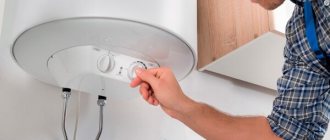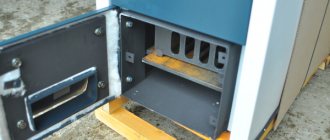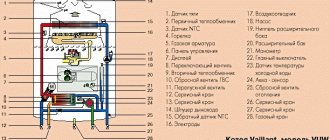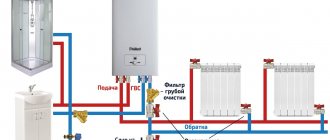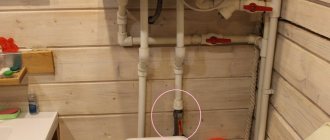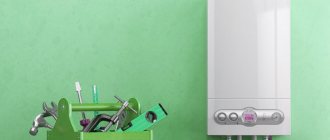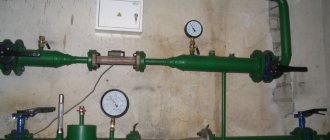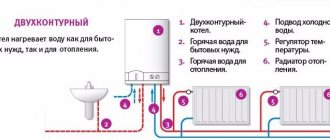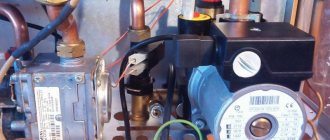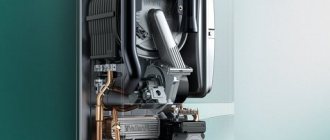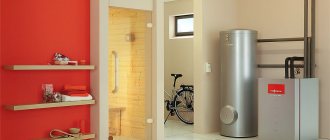Home / Gas boilers
Back
Published: 05/22/2019
Reading time: 2 min
10
32912
Gas boilers are designed to create comfortable living conditions. Double-circuit units provide the living space with heat and hot water at the tap. But it happens that a working boiler does not heat the water well and does not provide the necessary comfort.
The efficiency of the entire heating system depends on how the boiler operates. If there is a problem in the gas boiler itself, this can negatively affect the efficiency of the entire system and cause excessive consumption of energy resources. What happens when the boiler stops heating water? Let's look at the reasons and ways to solve this problem.
- 1 How does a boiler work?
- 2 The boiler does not heat water for heating
- 3 The boiler does not heat water for hot water supply
How does a boiler work?
To understand the situation more clearly, you need to understand the principle of operation of the boiler. Double-circuit gas wall-mounted boilers such as Baksi or Ariston consist of several components. In the gas part, the incoming fuel is burned, the water part ensures the supply of heated water from the heat exchangers to the heating system, and the smoke removal part is responsible for removing combustion products outside the home.
After starting the boiler, the pump is turned on to ensure the required water level in the system and the gas supply valve opens. The coolant moves in a heat exchanger, which is heated by a burner flame. The thermostat monitors the temperature in the room, temperature sensors monitor readings on the supply and return pipelines. Indicators of fuel pressure, coolant in the circuits, the presence of draft and combustion are also taken.
Depending on the user settings, temperature sensors adjust the water heating mode. A sensor on the return pipeline turns off the boiler, depending on the achievement of the required temperature set for the return. However, the system pump does not stop running until the heat exchanger temperature drops.
This is provided to prevent the water from boiling in it. As soon as the coolant cools down to the maximum level, the electronics will send a signal to turn on water pumping and the gas valve. The whole process will start again. When you open the tap in the mixer in a double-circuit boiler, a flow sensor reacts, which informs the electronics about the need to switch the three-way valve to the mode of heating water for DHW.
When the hot water tap is turned off, it returns to heating mode. Some manufacturers provide heating for both heat exchangers during periodic switching.
The principle of operation of a double-circuit heating boiler
Using a gas unit as an example, let’s look at the operating principle of a double-circuit boiler. The design of the unit is a system of blocks, the operation of which is interconnected and controlled by a security system, which includes various sensors. The main blocks are a gas block, where ignition and combustion occurs, a hydraulic block, which regulates the flow and pressure of liquid, and a smoke removal block, which removes gas combustion products.
When the boiler is turned on, the circulation pump is initially started, then gas is supplied using the gas valve. Automatic ignition ignites the gas, and as the gas burns, the heat exchanger heats up, heating the coolant passing through it. In this mode, the unit will work for some time until the parameters that are regulated by sensors change.
Sensors monitor the temperature in the room, in the return flow, gas pressure, system pressure, draft flow, and the presence of flame. Temperature sensors can regulate the temperature at the inlet or outlet of the heating circuit. If there is a sensor on the return, when the set temperature is reached, the thermostat sends a signal to the electronic board, which, after processing it, turns off the gas supply.
In this case, the circulation pump will run for some time to cool the heat exchanger. This is done so that the remaining heat in the heat exchanger does not bring the coolant to a boil. After the water in the system has cooled to the set temperature, the electronic board will start the pump, the gas valve will open the gas and the entire cycle of operation of the double-circuit boiler will be repeated.
When a hot water tap is opened, the flow sensor is activated and the control board switches the three-way valve to heat the secondary heat exchanger. Heating hot water in the system is a priority, i.e. immediately after you open the hot water tap, the entire system will only work to heat this water.
When the tap closes, the reverse process occurs - the board transmits a signal to the three-way valve, it closes the DHW system and the unit again starts working on the heating circuit. Please remember that it will take some time for the unit to produce hot water from your tap.
Some devices are equipped with a “quick start” or “comfort” function. This function allows the boiler to periodically switch the three-way valve and heat the water in the secondary coolant.
The boiler does not heat water for heating
So, let's look at the main reasons why a gas boiler does not heat water for the heating system and what to do about it:
- airlock. It is necessary to inspect the heating system for the presence of air in the radiators. To eliminate this problem, you need to install an air vent. Its operating principle is similar to that of an expansion tank, but it is capable of maintaining pressure in the system. Using an air vent, you need to bleed air from the system. It is important to inspect the valve itself for mechanical blockages - scale may be present there;
- corrosion in radiators. Clogging of heating devices can be determined by draining water from the system. If the water flows dirty, then you need to flush the system until visually clean water appears;
- connection errors. Hot water may not flow if the diameter of the pipes is not as specified in the project or instructions. It is necessary to check the compliance of the pipeline, the correct connection and the quality of installation of shut-off valves;
- insufficient pressure in the network. You should try adding water to the heating system, as there may not be enough pressure to trigger the automatic ignition of the burner;
- presence of scale in the heat exchanger. The first sign is prolonged heating of the coolant and heating of the batteries. It is necessary to get rid of sediments and carry out boiler water treatment. To do this, you need to disassemble the boiler and remove the heat exchanger assembly.
Before doing this, you need to shut off the flow of gas and water to the device. Then flexible connectors from the pump are connected to the heat exchanger and it is washed with a composition containing a special cleaning agent, which can be purchased over the counter. After which the parts are washed with water.
It is important to understand that adding chemical reagents to the coolant prevents and reduces the appearance of deposits on parts. But before using reagents, you need to read the boiler instructions, since some, Electrolux, Buderus, Navien or Arderia, do not provide for the use of chemical additives in the coolant. In this case, you can use water purification filters or distilled water.
Some manufacturers allow the use of antifreeze instead of water in the heating system. This substance can be used in the following boilers: “Baxi”, “Vaillant”, “Proterm”, “Beretta”, “Korea Star”. However, it should be understood that each manufacturer recommends using its own antifreeze;
- filter clogging. If the filter screens are clogged with mechanical debris, the radiators may also have poor heating. Therefore, the filter should be checked and cleaned regularly by rinsing with water. If clogging occurs too often, then such a part must be replaced;
- incorrect setting. First of all, if there is weak or no heating, you need to check the settings of the control unit. The temperature may be set insufficiently and the gas does not heat the water;
- malfunctions of pumping equipment. If the pump power is not enough to ensure good circulation, it may turn off if it overheats. This can happen when the DHW circuit is turned on;
- incorrectly selected heating devices. If the system has radiators with unsuitable heat transfer and design parameters, this can also lead to low heating;
- incorrect slope of pipelines. Most often this problem occurs in systems with natural circulation. Regulatory documentation specifies that the slope of pipes should be 10 mm per meter of pipe. If these requirements are not met, circulation may be disrupted and, as a result, there may be no heating due to low coolant flow.
The boiler is working but the radiators are cold
Cats don't sleep on cold radiators.
The efficiency of the entire heating system directly depends on the performance of the boiler. Malfunctions of the main heating equipment negatively affect the efficiency of the home heating circuit and lead to excessive energy consumption. That is why any breakdowns, even the most insignificant ones, are given special attention. People’s experiences are understandable if the boiler is working and the radiators are cold. After all, this not only reduces the level of comfort in the house, but also entails expensive repairs. To properly solve a problem, you need to understand its essence. Only a specialist can correctly determine the reasons why the boiler does not heat the batteries. Also read: “Why do radiators heat poorly?“.
Boiler malfunctions
Typical problems with the operation of heating equipment:
- malfunction of the built-in pump;
- the heat exchanger is clogged;
- The three-way valve does not work.
If the boiler is working and the radiators are cold, experts recommend, first of all, assessing the technical condition of the main heating element. More specifically, determine whether the circulation pump built into the device is working. This part is an invariable attribute of modern equipment and is designed to increase the efficiency of its operation. Very often, after a long period of inactivity in the summer, the pump can become clogged or become covered with a layer of limescale. As a result, it does not remove the heated coolant from the heat exchanger in a timely manner. The boiler is boiling, but the radiators are cold.
It is strictly prohibited to independently repair such complex equipment as a boiler. In this case, either a specialist from the service center or a repairman with the appropriate certificate or permit is called to your home.
Experts do not recommend using ordinary tap water as a coolant, as it is hard. When the coolant temperature increases, dissolved salts settle on the heat exchanger. As a result, the following problem arises: the boiler is working, but the radiators are barely warm. Scale reduces the thermal conductivity of the heat exchanger, so the water in the circuit does not heat up, although the heating element constantly works with excessive energy consumption. You can fix the problem by changing the coolant and cleaning the heat exchanger. This video will help you understand how to clean the heat exchanger correctly:
A double-circuit boiler heats water, but does not heat the radiators. Here you need to pay attention to the serviceability of the three-way electric valve. It is responsible for switching the bypass from heating circuit maintenance mode to DHW and CO mode.
Before making a heating register with your own hands, familiarize yourself with the technical base.
Why can't antifreeze be used for radiators? The answer is here.
Problems with the heating circuit
The pump must be selected according to the requirements of the heating circuit.
Malfunctions in the operating mode of the heating circuit are not always associated with a malfunction of the main heating element. If the boiler works, but does not heat the batteries, the reason must be sought in the wiring itself.
List of main heating circuit malfunctions:
- the filter on the return line or the needle tap (Maevsky tap) is clogged;
- insufficient power of the circulation pump;
- the rules for installing a heating circuit with natural circulation have not been followed.
Any of the above problems must be resolved before the start of the heating season. Otherwise, the room may be left without heat for several days, since the repair involves completely draining the coolant.
So, why doesn’t the boiler heat the batteries if everything worked fine over the previous years? The reason is a dirt plug that has formed on the heating circuit filter and completely blocks the coolant flow. It can be solved simply - the water is drained from the pipes or its circulation is blocked using bypasses, and the filter is cleaned. To prevent a recurrence of such a situation, it is necessary to completely replace the coolant with parallel flushing of the entire circuit.
In a gravity system, the slope of the pipes is key.
The second reason why the boiler works but the radiators are cold is the insufficient power of the circulation pump. The performance of the device is not enough to pump the entire volume of coolant in a timely and efficient manner. Or the heating system in the house has branches that are located at a significant distance from the pump. As a result, the circulation pump overheats, the heating equipment operates with excessive energy consumption, and the radiators remain cold. The solution is to change the coolant pumping device to a more powerful one.
If the house has a two-pipe heating circuit with natural circulation of water, and during the heating season it is often noticed that the boiler is on and the radiators are cold, then the reason lies in non-compliance with the slope of the main line. According to regulatory documentation, only a pipe slope of 10 mm per linear meter in a heating system with natural circulation will ensure normal coolant movement. The result is uniform heating of the batteries throughout the house. If there is no slope, the coolant stagnates, which negatively affects the temperature of the radiators. The problem can be solved by completely redoing the wiring.
Is it possible to heat a garage using antifreeze for cars?
Which liquid to clean heating systems should you choose? The selection criteria are described here.
Why are the radiators cold when the boiler is running?
Low efficiency of the heating system can be the result of malfunctions of both the circuit itself and the main heating element. In the case of a heating device, it is necessary to pay attention to the three-way valve, the functionality of the pump and the technical condition of the heat exchanger. Typical problems for heating wiring are a clogged filter, insufficient power of the circulation pump and lack of slope of the pipes of the circuit with natural water circulation.
utepleniedoma.com
